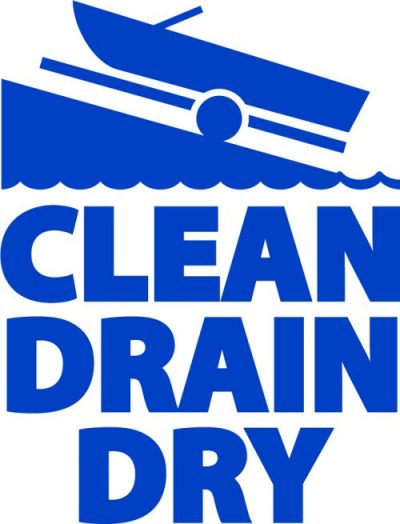
Clean Drain Dry encourages recreationists to clean, drain, and dry all boats and equipment to help reduce the spread of invasive plants and organisms into and between BC’s lakes and rivers. Invasive plants and animals can be moved between water bodies by “hitchhiking” on boats, trailers, SUP’s, kayaks, fishing gear, and bait buckets. Using proper technique to remove aquatic animal and plant material from your gear before moving your it to a new water body helps to prevent the spread of invasives.
Follow these steps to effectively Clean Drain Dry:
- CLEAN off all plant parts, animals, and mud from boat and equipment (e.g. boots, waders, fishing gear). Use a power wash station if available.
- DRAIN onto land all items that can hold water (e.g. buckets, wells, bilge, and ballast).
- DRY all items completely before launching into another body of water.

2024 Clean Drain Dry Directives
In light of the recent spread of Whirling disease, and the ever-present threat of invasive mussels, the government of BC has issued a new order that makes it illegal to transport a watercraft in BC with the drain plug still in place. The order became official on May 17th, 2024, and is a great step forward in protecting local water bodies from invasive species.
Draining boats and other watercrafts before moving them significantly reduces the chances for an invasive plant or organism to “hitchhike” to a new body of water. Remember to practice Clean Drain Dry protocol when spending time outside on the water.
Check out our blog post and the BC government website to learn more.

Frequently Asked Questions
Who runs the Clean Drain Dry program?
The Clean, Drain, Dry outreach program is operated by the Invasive Species Council of B.C. in partnership with the B.C. provincial government, Freshwater Fisheries Society of B.C., the B.C. Wildlife Federation, lakeside stewardship groups, and regional invasive species committees.
Is it illegal to transport invasive mussels?
It is illegal to transport invasive mussels anywhere in B.C. Fines are up to $50,000 for a first offense for illegally transporting mussels in B.C.
What is the Sea to Sky Invasive Species Council doing to help?
 SSISC staff visit boat launches throughout the Sea to Sky, informing recreationists about Clean Drain Dry and surveying boaters to gather further information about the movement of boats into and out of the region to inform future outreach. SSISC also actively monitors Sea to Sky lakes for the presence of invasive mussels. In addition, SSISC works with local government to develop and install informative signage for high usage boat launches. Throughout the season, the Clean Drain Dry messaging is shared at events, outreach booths, the SSISC website, and via social media streams.
SSISC staff visit boat launches throughout the Sea to Sky, informing recreationists about Clean Drain Dry and surveying boaters to gather further information about the movement of boats into and out of the region to inform future outreach. SSISC also actively monitors Sea to Sky lakes for the presence of invasive mussels. In addition, SSISC works with local government to develop and install informative signage for high usage boat launches. Throughout the season, the Clean Drain Dry messaging is shared at events, outreach booths, the SSISC website, and via social media streams.
Resources
Local Supporters
Links
Learn how to identify & prevent the spread of aquatic invasives
In just 30 minutes, you will learn about 9 different aquatic invasive species – how to identify them, their impacts and current distribution within the Sea to Sky, and how you can protect our community by preventing further spread. The Aquatic Invasives 101 course is completely free, online, and family-friendly.
The Clean Drain Dry program empowers you to help reduce the spread of invasive plants and organisms to BC waters.
The B.C Invasive Mussel Defence program’s goal is to prevent the introduction of Zebra and Quagga Mussels into B.C. The program’s prevention efforts are focused on inspecting boats, monitoring lakes, educating the public and coordinating actions with neighbouring jurisdictions.
The Don’t Love It To Death campaign is a reminder to travellers and outdoor enthusiasts to be mindful of the impact of their behaviour and activities on the Sea-to-Sky Corridor’s delicate ecosystems. While visiting, we invite you to treat the region with the same care and consideration you would your own backyard. This means conducting yourself in a responsible, respectful manner toward the environment, communities, and wildlife to help protect and preserve our natural heritage for future generations.
Founded by the U.S. Geological Survey, Great Lakes Commission, National Oceanic and Atmospheric Administration, and Great Lakes Fishery Commission, the Invasive Mussel Collaborative seeks to produce measurable ecological and economic benefits through the advancement of scientifically sound technologies designed to control Zebra and Quagga Mussels.
The Collaborative’s membership includes 36 federal, state, provincial, and tribal agencies, non-government groups, research institutions, private industries, etc.
You might also like…
- Information for water lovers
- American Bullfrog species profile page
- European Green Crab profile page
- Goldfish species profile page
- Red-Eared Slider Turtle species profile page
- Zebra and Quagga Mussels species profile page
- Curled Pondweed species profile page
- Eurasian Watermilfoil species profile page
- Fragrant Water Lily species profile page
- Water Lettuce species profile page







